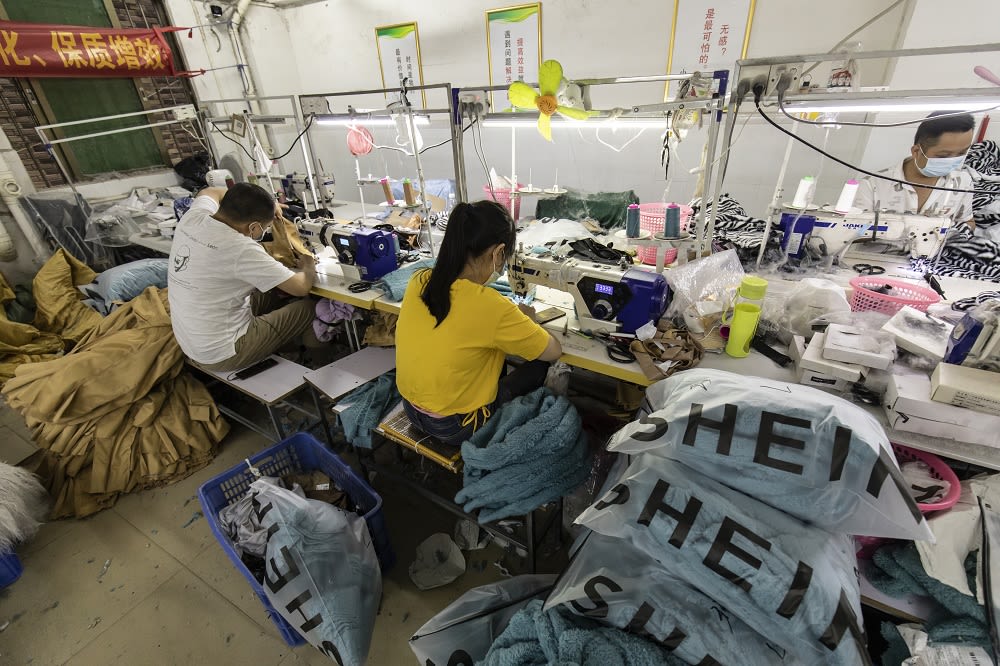The Shein effect: Is fashion stuck in a race to the bottom?
Shein has moved from its humble beginnings as a small player in the ultra-fast fashion world to a global juggernaut – reshaping the fashion market with rock-bottom prices, a lightning-fast supply chain, and dominant social media presence.
And the fashion etailer’s ascendency shows no signs of slowing as GlobalData predicts it will become the UK’s sixth-largest apparel retailer by 2027.
But as the Chinese giant continues its rise, it raises a crucial question: Are fashion retailers chasing Shein’s unsustainable pricing model, or can they strike a balance between affordability and responsibility in a market that’s increasingly scrutinising both?
Will controversy affect its £50bn IPO ambitions?
As Shein targets a £50bn IPO in London, how will its controversial practices—particularly around supply chain transparency and labour standards—impact its perceived value with investors?
The company has been hit with more hurdles this week as campaigners launched a fresh attempt to block its listing. They’re calling for a judicial review over allegations that the fast fashion giant has benefited from forced labour, claiming that its profits could be the “proceeds of crime.”
Meanwhile, recent changes to US tariffs threaten to upend its business model. The potential end of the de minimis exemption for small packages could lead to steep import duties on its US shipments, putting pressure on its sales and growth plans.
Despite these hurdles, Jack Stratten, director of Insider Trends, suggests that Shein’s valuation may still hold steady.
While sustainability and ethics matter more to investors amid growing consumer scrutiny, Stratten says “the UK financial sector is desperate for an attention-grabbing, meaty IPO”, which may overshadow concerns about Shein’s ethical practices.
He also notes that “the vast majority of shoppers either don’t know about Shein’s unethical practices, or don’t care”, suggesting consumer sentiment may not change much soon.
Stratten also believes Shein’s biggest threat may come from fast fashion players replicating its model and using AI to boost product variety. “Newness is an incredibly important asset for a brand today, and if a newer Shein comes along, it isn’t hard to imagine Gen Z, or indeed Gen Alpha, jumping ship.”
Sarah Johnson, founder of Flourish Retail and ex-Asos, adds that governance is a “critical factor in Shein’s future growth and scalability”.
“The company’s lack of transparency around supply chain practices and labour standards presents a significant risk to its long-term prospects, impacting profitability.
“Boohoo and PrettyLittleThing have already felt the consequences of this, with changing consumer perception leading to declining valuations.
“If ethical and sustainable consumption continues to gain momentum, Shein could face similar challenges,” she says.
Johnson explains that from an investment perspective, long-term viability must be assessed both ethically and financially. With increased regulatory scrutiny and evolving consumer values, she says investors must weigh these risks against Shein’s market dominance.

Shein’s ultra-fast model: Is it sustainable?
Johnson says Shein’s success lies in speed, data-driven design, and small-batch production, enabling quick reactions to trends.
But, she says, “this ultra-fast model is increasingly linked to environmental concerns, such as overproduction and the culture of overconsumption”.
“Alongside this, allegations of poor working conditions, child labour, and below-minimum-wage pay continue to raise ethical questions about its supply chain.”
Johnson believes Shein’s long-term success hinges on its ability to address supply chain transparency, environmental impact, and worker treatment. However, she notes that consumer priorities have done little to necessitate this shift so far.
Meanwhile, Rhea Fox, former digital director at Ted Baker and Monsoon Accessorize says “the prognosis for low-priced fast fashion is a difficult one right now”, largely due to Shein’s ability to churn out designs at a speed and scale that traditional retailers struggle to match. More established fashion retailers have slower, more traditional production cycles, leaving them scrambling to keep up with Shein.
“Shein is disrupting the lowest-priced, trend-led segment of the market, while consumers are increasingly trading up to slightly higher price points, often through pre-loved options.”
Despite Shein’s dominance in speed and pricing, sustainability concerns remain increasingly influential in consumer purchasing decisions. Ethical practices are still factoring into choices, even if affordability remains a priority.
Ethical concerns and sustainability are increasingly influencing purchase decisions, with Fox noting that “Zara’s small-batch model reduces waste, but it can’t match Shein’s speed without compromising on quality, legislation, and ethics”.
Fox suggests that it’s less about Gen Z being unaware of ethical issues, and more about them not prioritising them when it comes to purchasing decisions. “This group isn’t watching Panorama documentaries.”

Shein’s impact on UK fast fashion giants
Shein surpassed Boohoo in the UK last year, with sales rising 38% to £1.55bn, compared to Boohoo’s £1.09bn. Shein’s pre-tax profits in the UK doubled from £12.2m to £24.4m in 2024.
Fox notes “it’s a huge impact”, adding that platforms like Vinted are also capturing market share. The Lithuanian second-hand marketplace saw a 61% sales surge last year and posted its first-ever profit, highlighting the rising demand for sustainable fashion alternatives.
“If Vinted is the 7th biggest online apparel retailer in Europe and Shien is growing super-fast that’s predominantly going to hit the value-led youth end of the market.”
For traditional brands to stay competitive, Fox suggests focusing on brand-building, customer loyalty, and offering premium, sustainable items such as handbags or coats to differentiate from Shein’s hyper-fast trends.
Meanwhile Stratten adds: “Shein is an excuse for other fast-fashion businesses who don’t innovate enough.”
He explains that the market is saturated, and “Boohoo, Asos, and others don’t stand out” – calling the shopping experience and product choice “completely unremarkable”.
He notes that Shein removed the ‘middle man’ costs, took advantage of subsequent shipping fee exemptions, and “pushed prices that no other business could – or should – compete with”.
He adds that its growth strategy has been “based on gaining market share at any cost – which meant initially they weren’t even concerned with making a profit on items sold. There is no retailer that can compete with that”.
Stratten also believes that Shein’s success is linked to its ability to engage Gen Z through social media and influencer partnerships.
He points out that “a poorly executed Shein campaign will gain traction, and a brilliantly executed campaign by H&M won’t to the same degree”. The key factor? Authenticity. Gen Z often perceives legacy brands like H&M as less authentic, while Shein continues to be seen as “new and disruptive”>
Fox agrees, noting that traditional brands are struggling to compete in this space because they are not resonating with Gen Z shoppers the way Shein does.
“Shein’s influencer-driven campaigns have a sense of authenticity that traditional retailers can’t match,” she says. “Even when Shein’s campaigns aren’t perfect, they still manage to generate more buzz than highly polished ones from the likes of H&M.”
Stratten suggests that this engagement is crucial for Shein’s model, and it’s not just about influencer partnerships but also the brand’s ability to remain seen as fresh and relevant in an oversaturated market.
“If traditional retailers can improve their engagement and better align with Gen Z’s values, they can begin to close the gap,” he adds. “But Shein’s price and business model will continue to set it apart.”
Can traditional retailers compete on sustainability?
As Shein’s dominance grows, traditional retailers face the challenge of competing with its ultra-fast, low-cost model. But can they balance sustainability with speed and affordability, or should they rethink their approach entirely?
Shein’s use of small-scale suppliers allows it to quickly scale production, a key factor in its success. For traditional retailers, improving supply chain agility without compromising on ethical standards or quality remains a significant hurdle.
Johnson believes a key opportunity for fashion brands is to “bring production closer to home”.
She explains that local supply chains would speed up time to market, enabling brands to react more effectively through test-and-repeat models or pre-orders.
This approach, she notes, would reduce overproduction, ensure only necessary items are manufactured, and boost the economy. However, Johnson also highlights a critical shift that’s needed in the industry: moving away from focusing on intake margins (profit made when a garment is brought in) to focusing on exit margin, which reflects profitability after discounting.
She says: “The industry’s long-standing focus on intake margins has continued to drive pricing strategies that often result in over-buying, excessive discounting, and, ultimately, brand erosion. Once caught in this cycle, it’s difficult to escape—but not impossible.”
While these shifts could help traditional retailers improve their sustainability efforts, it raises the question: Should they even bother competing with Shein on price and speed, or is there space for differentiation in areas like sustainability and ethics?
Fox believes there is certainly space for differentiation in sustainability and ethics, citing brands like Primark that are trying to embrace more sustainable practices.
Primark’s latest sustainability report highlights a 21% reduction in Scope 1 and 2 emissions, with nearly two-thirds of clothing now containing recycled or sustainably sourced materials. They’ve also introduced initiatives like the Circular Product Standard, promoting sustainable designs and better recycling.
However, Fox acknowledges the difficulty in attracting sustainability-focused shoppers when competing with Shein’s low prices.
“Those customers who genuinely value sustainability and can afford it are probably not—and may never be—the Shein audience,” she says.
She points out that while brands like Baukjem and BAM are growing in the sustainable fashion space, “it’s not the same consumer or the same fight.”
Competing on sustainability while also maintaining price and speed is a difficult balancing act, and Fox believes it’s one that many fast-fashion brands won’t win.
“Brands in the current tough climate are going to have to pick a hill to die on,” she says. “Trying to compete on price and trends while also focusing on sustainability seems like a strategy doomed to satisfy nobody.”
Stratten agrees, noting that traditional fast-fashion brands can’t compete with Shein’s speed and pricing if they attempt to prioritise sustainability. “The only way for legacy fast-fashion brands to compete while attempting sustainability is to premiumise their offering, increase their prices, and use the assets they possess that Shein doesn’t—perhaps most notably, stores.”
He suggests that traditional retailers should focus on why their clothing is better, the experiences and convenience their stores offer, and the story and heritage of their brands. “In other words, be the opposite of Shein,” he says.
“We can already see evidence of this premiumisation strategy happening in H&M, Zara, and Uniqlo. We don’t yet know whether it will work, but I don’t believe there is any other reasonable option as a legacy retailer.”
 The role of regulators
The role of regulators
Johnson thinks regulators should hold Shein to the same level of scrutiny as UK-based brands.
“Just as other fashion retailers must demonstrate compliance with minimum wage laws, fair working conditions, and anti-slavery measures, Shein should be required to prove adherence to these standards before being allowed to list on the London Stock Exchange”.
While consumers play a role in driving ethical change, she emphasises that “accountability must start at the regulatory level”.
“Without strict oversight, brands that exploit poor labour practices can continue to profit, creating an unfair advantage over those committed to ethical and sustainable operations. Ensuring a level playing field is crucial—not just for fairness in the industry, but for the future of responsible retail.”
As Shein’s dominance continues to reshape the fast fashion landscape, its growth presents significant challenges for traditional retailers, regulators, and consumers alike.
While its low prices and speed have set a new benchmark, the long-term sustainability of its model remains in question.
With Shein’s £50bn IPO on the horizon, its pricing strategy and production scale could not only define the company’s future but also influence the broader fashion industry—leaving the question of whether the sector is locked in a race to the bottom or if a shift toward more sustainable, ethical practices is within reach.
Click here to sign up to Retail Gazette‘s free daily email newsletter
February 5, 2025 at 09:06AM
https://ift.tt/eSqYaoG
Georgia Wright

